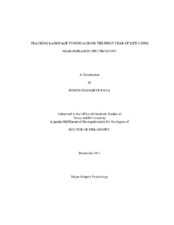| dc.description.abstract | Both behavioral and neurophysiological data indicate that many factors contribute to how infants tune to their native language(s) in early infancy. However, substantial debate remains regarding the neural mechanisms that underlie this tuning process. This study was designed to determine whether the behavioral changes in infants' processing of native and non-native speech during the second half of the first year correspond to qualitative neural processing changes that can be measured using near-infrared spectroscopy (NIRS). Specifically, we used NIRS to examine changes in hemodynamic activity in monolingually-exposed infants between the ages of 3 and 14 months while they were exposed to native (English) and non-native (Spanish) speech. In all infants, measurements were taken from the bilateral temporal regions of the cerebral cortex. Three age groups were tested: pre-tuned infants, who should show no sensitivity to phonological differences between the native and non-native speech samples (3-to-6-month-olds), actively tuning infants, who should be beginning to differentiate between the phonology of the native and non-native speech samples (7-to-10-month-olds), and tuned infants, who should readily distinguish between the phonologies of the native and non-native speech samples (11-to-14-month-olds). Results demonstrated significant differences in hemodynamic activity during the processing of native speech compared to non-native speech in each of the three age groups, with qualitatively different patterns of hemispheric lateralization emerging in response to the two types of speech in each of the three groups. These findings point to a potential neural marker of infants' sensitivity to the phonology of their native language as it emerges with increasing age that will be useful in future research. | en |


